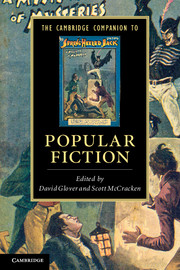Book contents
- Frontmatter
- Introduction
- 1 Publishing, history, genre
- 2 Fiction, theatre and early cinema
- 3 Television and serial fictions
- 4 The public sphere, popular culture and the true meaning of the zombie apocalypse
- 5 The reader of popular fiction
- 6 Reading time: popular fiction and the everyday
- 7 Gender and sexuality in popular fiction
- 8 Pulp sensations
- 9 Bestselling fiction: machinery, economy, excess
- 10 Comic books and graphic novels
- 11 Popular fiction in the digital age
- Further reading
- Index
- Cambridge Companions to …
2 - Fiction, theatre and early cinema
Published online by Cambridge University Press: 28 May 2012
- Frontmatter
- Introduction
- 1 Publishing, history, genre
- 2 Fiction, theatre and early cinema
- 3 Television and serial fictions
- 4 The public sphere, popular culture and the true meaning of the zombie apocalypse
- 5 The reader of popular fiction
- 6 Reading time: popular fiction and the everyday
- 7 Gender and sexuality in popular fiction
- 8 Pulp sensations
- 9 Bestselling fiction: machinery, economy, excess
- 10 Comic books and graphic novels
- 11 Popular fiction in the digital age
- Further reading
- Index
- Cambridge Companions to …
Summary
It was widely averred in the nineteenth century that the novel was the century's dominant form; indeed, at the end of this period critics spoke of the ‘tyranny’ of the novel. But this was only a partial truth, insofar as for much of this period the novel maintained complicated symbiotic relationships with other cultural forms, particularly drama: in this respect, popular plots, characters and settings were amphibious, gliding from novel to stage, and, more rarely, from stage to novel. The reading of novels aloud in the family home was an aspect of Victorian literary culture that already contained elements of theatricality, and this was still more the case with the commercially run, public readings that swelled the finances of popular novelists, notably Dickens. But by the time audiences heard Dickens read from his favourite works (the death of Nancy from Oliver Twist (1837–9) was his tour de force) many of them would have already seen full, sometimes unauthorised, dramatic adaptations of the same texts: Nicholas Nickleby (1838–9) as Smike; The Cricket on the Hearth (1845) as Dot; other novels and shorter pieces under their original titles. The work of other novelists, from Bulwer Lytton, to Elizabeth Gaskell, to M. E. Braddon, was also quickly revamped for the stage; the vogue of ‘sensation’ in the 1860s coincides with an especially lively period of adaptation, as the reign of the Newgate Novel had in the 1830s and 1840s.
- Type
- Chapter
- Information
- The Cambridge Companion to Popular Fiction , pp. 33 - 49Publisher: Cambridge University PressPrint publication year: 2012
- 3
- Cited by

